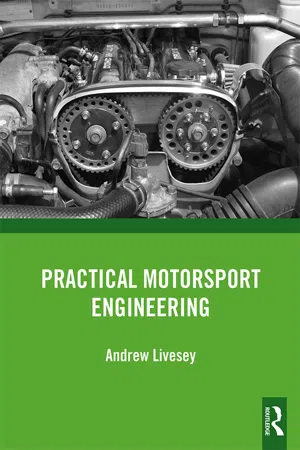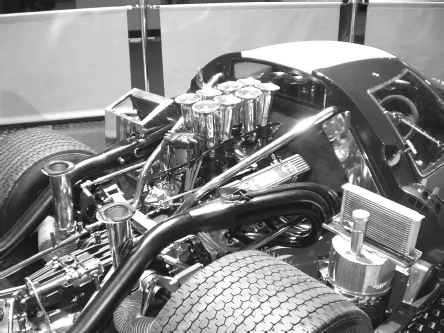![]()
Chapter 1
Power unit – engine
There ain’t no substitute for cubes.
Whether it’s cubic inches or cubic centimetres, the more of them that you have in your engine the more power you can develop. That’s how it is for petrol and diesel engines – with electric motors it volts and amps you need.
Motorsport is often grouped into engine sizes, so the competitor is challenged to get the most power out of the engine. There are also usually regulations on what is, and is not, allowed to improve the power output.
Terminology
The term horse power – HP – comes from steam engine sales agents of about two hundred years ago saying how many horses their engines could replace. In French this is Cheval Vapour – CV; in German this is Pferde Starke – PS.
1 HP, in any language, that is CV, or PS is equal to 746 watts.
When we are talking about power output we must be careful to compare like for like. When we say BHP brake horse power we are talking about the engine power measured on an engine brake or dynamometer – dyno. But rolling road dynamometers measure power at the wheels – this is after the frictional losses in the transmission system – typically around 10–15%. Also, there are a number of different standards for measuring power outputs set by different organisations, the most popular are the American SAE standard and the German DIN standard. Both measure power but under different conditions – variations like the use of air filters and the way that the cooling system is connected.
Power is about doing work in amount of time – mathematically work done per unit time.
Identification
Identification of the engine before working on it is very important. The VIN number will help identify the type, or classification, of the engine. The detail of the engine will be given in a separate engine number, the prefix will identify the engine type, and the serial number will identify the exact engine.
Figure 1.1 Lola T70B V8 engine
With motorsport engines the build may be completely different to standard; for this reason you should keep a log of the engine build, detailing all the components including part numbers, sizes, and any other variants.
Engine performance
The two common terms used in motorsport are:
- Power – this is work done in unit time.
- Torque – turning moment about a point.
Let’s discuss them for clarity then look at the calculations. When we are using the term power we are referring to how much energy the engine has. A big heavy car needs a big powerful engine. Power is about doing work in a time period, it means burning fuel in the time period. We can make a small four-cylinder engine – say one from a motorcycle like a Kawasaki ZX6R produce over 100 BHP from its 600 cc; but we need it to revving at about 12,000 rpm. Such engines are used in clubman cars; but starting from rest necessitates slipping the clutch until the car reaches about 30 mph. The torque produced by such an engine is very low. On the other hand, a large slow revving 2 or 3 litre diesel engine as used in many commercial vehicles will set off at about 500 rpm and pull a big payload; it is designed to have lots of torque.
For a mathematical definition of these terms we need to start with work done. Work done is the amount of load carried multiplied by the distance travelled. The load is converted into force, the force needed to move the car for instance in Newtons (N). The distance is measured in metres. That is:
As we also express torque in Nm, so it is common to use the term joule (J) for work done.
Racer note
Joule is a term for energy. 1 J = 1 Nm
If we use a force of 10,000 N to take a dragster down a 200 m drag strip then we have exerted 2,000,000 Nm, or 2,000,000 J. We’d say two mega joules (2 MJ). We’d need to get this amount of energy out of the fuel that we were using.
The force is generated by the pressure of the burning gas on top of the piston multiplied by the area of the top of the piston. So, the work done is the mean (average) force of pushing the piston down the cylinder bore multiplied by the distance travelled.
Example
The work done during the power stroke of an engine where the stroke is 60mm and the mean force is 5kN:
Racer note
The mathematical symbols used in this book are those found on your calculator or mobile phone,
* is multiply and / is divide
The same mean force is going to create the torque; this time we are going to use the crankshaft throw – this is half of the length of the stroke.
Example
Using the same engine:
The work done by a torque for one revolution is the mean force multiplied by the circumference. The circumference is 2Πr so:
That is for one revolution. For any number of revolutions, where n is any number, the formula is:
Example
Using the same engine of the previous examples.
The work done in 1 minute at 6,000 rpm will be:
Power is, as we said; work done in unit time, which is:
The motorsport industry uses a number of different units and standards for power, from our calculations we can use watts (W) and kilowatts (kW) and then convert:
Example
Following on from our engine in the previous calculations and examples:
The term horse power (HP or hp) was derived by James Watt as the average power of a pit pony. These were small horses used to turn pulleys to draw water from Cornish tin mines (pits) before steam power became more popular. He equated the power of his steam engines to a number of these pit ponies. For our purposes 1 HP equals 33,000 ftlb/minute.
In French, horse power is cheval vapour (CV); in German it is Pferde Stracker (PS).
For conversion purposes 1 HP is equal to 746 W.
When talking about power and doing work the weight of the vehicle comes into play. A vehicle like a clubman’s car such as Caterham or a Westfield with a small engine can...

